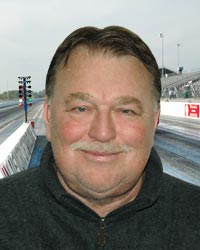|
|||||||||||||||||||||||||||||||||||||||||||||||||||||

Revisiting a few subjects
5/8/06

![]() ncompetent, uninformed, blind, or just plain apathetic. All of these words, in my opinion, could be applied to NHRA officials who ultimately make or don’t make rules relating to the safety of perhaps the most dangerous cars in all of auto racing: 330-mph Top Fuel and Funny Cars. And, yes, despite all the efforts of Ray Alley to slow the cars down, Alan Johnson and others have proven they can compensate for the rev-limiter, 85% nitro and everything else.
ncompetent, uninformed, blind, or just plain apathetic. All of these words, in my opinion, could be applied to NHRA officials who ultimately make or don’t make rules relating to the safety of perhaps the most dangerous cars in all of auto racing: 330-mph Top Fuel and Funny Cars. And, yes, despite all the efforts of Ray Alley to slow the cars down, Alan Johnson and others have proven they can compensate for the rev-limiter, 85% nitro and everything else.
Cory McClenathan's crash at Bristol and Brandon Bernstein’s tire failure at Atlanta are viable proof that despite the efforts of Alley and the Goodyear engineers, the sport appears no closer to really making Top Fuel cars safer. Rear tires are still failing and now, despite a heat treat fix, the arching and flexing of the frame rails results in failure. It would appear, almost two years after Darrell Russell died, that those who control the sport still can’t resolve the issue of tire failure or chassis fatigue.
The sport of drag racing has been very lucky. The sport could have easily lost a couple of star drivers recently. Who knows how badly Cory McClenathan might have been injured in his crash had he not been wearing a head and neck device (which, by the way, the NHRA still hasn’t made a mandatory piece of safety equipment).
On Friday at Atlanta Brandon Bernstein was the victim of yet another exploded rear tire. Luckily for him the exploding tire pieces didn’t take the wing out or he could have had very serious problems. When a tire explodes these guys are just praying that it doesn’t take the wing off as has happened many times in the past. The problem remains that tires are still chunking and failing and there is no indication that a cure is coming. And worse yet, NHRA’s solution is to attempt to censure the crews and drivers and deny there is a problem as if ignoring it will make it go away.
The law of averages and common sense dictate that if drastic changes to Top Fuel chassis and wing specs aren't made -- and soon -- then it could be said that the sport has learned nothing from Darrell Russell’s tragic death. (By the way, a zero angle of attack for the wing while the car is sitting still means nothing when the rear tire grows and the chassis pivots drastically, increasing the angle of attack for the wing as it goes down the track.)
Sadly, a friend of mine in the insurance business believes that NHRA will only take really effective measures to make the cars and tires safer if they lose the Darrell Russell case and NHRA’s insurance company has to pay off. He believes the insurance companies will then force them to make rules to keep that from happening again.
It is an inescapable fact that driving and racing IHRA or NHRA nitro-burning cars is a very dangerous occupation, but aren’t the sanctioning bodies by their very charter charged with making rules that mitigate the danger to the driver? The fact is the sanctioning bodies aren’t doing enough, and why they haven’t is going to be hard to explain to the next wife of a nitro car racer who is severely injured, paralyzed, or killed in a crash caused by an exploding tire or because he wasn’t wearing a head and neck restraint device. John Lingenfelter's crash and injury is just example of why HANS devices should be made mandatory for every driver.
It took more than 20 years after Don Garlits's and Eddie Hill’s spectacular blowovers for the NHRA tech department to finally make wheelie bars mandatory for Top Fuel and Funny Cars. Many people, including myself, lobbied hard for that rule immediately after Hill’s spectacular crash. Resistance from team owners, racers, tuners and -- unbelievably! -- chassis builders kept that rule from being written. “It won’t prevent blowovers," they said. They have been proven dead wrong which almost everyone knew then. Some racers just didn’t want to add the weight to their cars, safety be damned. Shamefully, the NHRA tech department apparently didn’t have the will to buck their racers to do the right thing.
I believe that the resistance to make needed safety changes, such as mandatory head and neck restraint devices, chassis specs that mandate thicker wall main rail tubing and smaller area rear wings to keep chassis from flexing like a wet noodle as it goes down track, comes from some of the same car owners and tuners who opposed the wheelie bars. The fact is the cars won’t hook up as well if they don’t flex. The inmates are running the asylum for Chrissake!
It should be obvious to everyone by now that Goodyear either can’t or won’t build a tire that is safe at 330 mph, much less faster speeds. The problem really isn’t the Goodyear Company’s fault. It’s an open secret in the business that Goodyear has repeatedly told the NHRA and racers that the Top Fuel and Funny Cars are simply going way too fast for their tires. I believe the NHRA tech department has done everything recommended by Goodyear to prevent tire failure, such as reducing rear wing angle and adjusting tire pressure. Now it is time for NHRA to shoulder the burden and take the next step.
When fuel cars were running at speeds just over 300 mph tires weren’t an issue. The fact is the slower the car is traveling the less down force the wings make. Slowing the cars down buy reducing wing area can’t hurt and if cars aren’t accelerating at a rate that will deliver 330+ speeds they might not need a huge wing to keep the cars straight.
It’s time for Tom Compton or Dallas Gardner or Wally Parks to address the safety issue and fix it. Safety, not profit, used to be the cornerstone of NHRA drag racing. Just as the commissioner of baseball can make difficult and controversial decisions “for the good of the sport,” so should the men in charge of professional drag racing. Isn’t making the tough decisions what they’re getting paid those six-figure salaries to do?
Everyone acknowledges that 300-mph dragsters or funny fuel cars are the draw for drag racing, so the cars have to be able to exceed that mark, but it’s my opinion that neither the fans nor the mainstream press care whether Jack Wyatt goes 305 or John Force runs 325; just as long as someone exceeds 300 mph during a race everyone is happy.
So, why not make some rules that not only would make racing safer and more affordable, but at the same time make a 300-mph pass something rare, special and newsworthy again?
I know many of you are tired of me beating this drum, and I know that many people at NHRA actually despise me for these columns about safety. But I don’t care because I feel they are needlessly putting friends and acquaintances of mine at risk just for someone’s entertainment and money and no other reason. That is morally wrong and I don’t care if every driver is a volunteer. I’ll bet his wife or her husband or their kids aren’t.
MINI-BLASTS
The problem I see with many Nostalgia Funny Car teams is they want to be treated and paid like a professional but they don’t act, look, or run like one. I still like them though.
If more bracket racing announcers gave reaction times and margin of victory numbers, bracket racing would be a lot more entertaining to fans. DRO contributor David Anderson advocates a Jumbo-tron for fans at big bracket racing, and I like the idea. I don’t think promoters of today’s mega-buck bracket races want or need spectators.
|
Don Schumacher, please no more funny teeth and goofy glasses on TV. Drag racing is serious business.
Don’t the talking heads and NHRA know that women have been super stars of drag racing for more than 30 years? Whatever happened to Danica Patrick? Who?
Please, please, drag racing TV producers, I’m begging you, don’t let your on-air talent talk over the sound of a fuel engine at idle or going down track. Turn up the volume and let the folks at home hear 15 seconds of a nitro motor the way it really sounds. You can't give the audience the smell of nitro, but you can make them understand part of the physical experience that is drag racing.![]()

